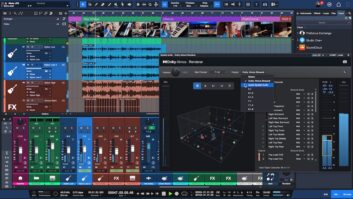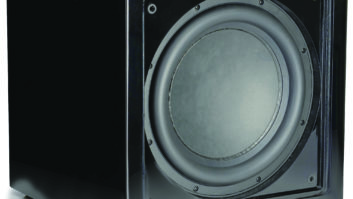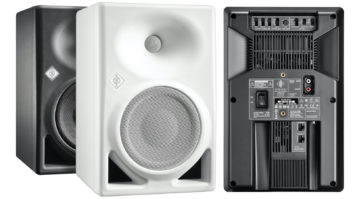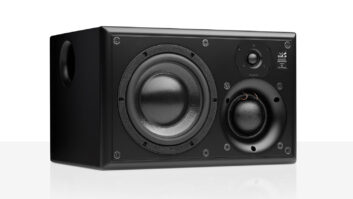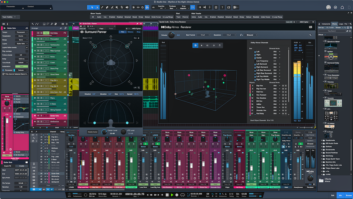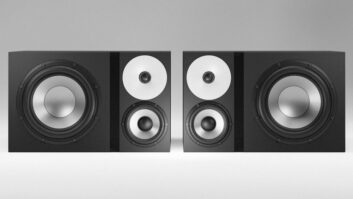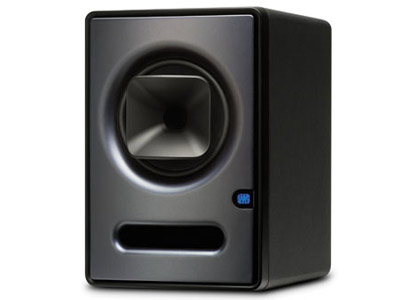
Coaxial, or dual-concentric, speakers have been around for several decades, falling in and out of favor. The PreSonus Sceptre S6 active studio monitor combines the best attributes of coaxial design with corrective built-in DSP that purportedly removes the artifacts that have been the archetype’s downside.
HORN-LOADED DESIGN
In the S6, a horn-loaded 1” compression tweeter is mounted coaxially at the center of a 6.5” composite (glass-reinforced paper) cone woofer (see Fig. 1). The coaxial design causes most of the sound to emanate from one spot in the cabinet, providing virtual point-source imaging.
Despite its advantages, such a design can introduce unwanted artifacts. The upper frequencies produced by the woofer can diffract off the horn positioned in front of it, resulting in an acoustic shadow. (Lower frequencies have longer wavelengths that can more readily wrap around an obstacle to propogate.) The close placement of the two structures can cause intermodulation distortion, wherein the low frequencies from the woofer modulate the tweeter’s highs. Sound emanating from the rear of the horn can bounce off the woofer cone, creating a delayed path to the listener’s ears and manifesting in comb filtering and smeared imaging.
To correct these artifacts, the S6 uses proprietary 32-bit floating-point DSP along with TQ™ Temporal Equalization Technology designed by Fulcrum Acoustic. Running at 48 kHz, the DSP algorithms use a combination of Infinite Impulse Response (IIR) high-pass, low-pass and parametric filters; delay (to time-align the woofer and tweeter); and Finite Impulse Response (FIR) filters.
A front-firing, oval bass-reflex slot extends the monitor’s bass-frequency response. The sides of the vinyl-laminated MDF cabinet are rounded at top and bottom to preclude diffractive effects. I was initially concerned that a slot that surrounds the front baffle around the cabinet’s inside edges might cause diffraction of high frequencies. But as you’ll read later in my review, the S6’s imaging is completely faultless.
The woofer and tweeter are each powered by a 90W Class D amplifier; the amps are fitted with heat sinks inside the cabinet. Other built-in electronics provide output-current limiting, protection from overheating and a subsonic filter. An internal mains fuse protects the speakers from damage. A transient-protection circuit ostensibly prevents popping when powering the speakers on and off. In practice, I heard a low-level click when powering up—nothing of any consequence. An LED lights blue behind a logo on the front panel when the monitor is on; it lights red when clipping occurs (including that caused by powering up).

REAR-PANEL FACILITIES
Three sets of filters on the cabinet’s rear panel are adjusted via respective pushbutton controls to change the S6’s frequency response; use these filters to compensate for potential suboptimal monitor placement and unbalanced room tone (see Fig. 2). Each time you press a pushbutton, it advances its associated filter to its next preset setting in wraparound fashion. The Acoustic Space filter alternately provides 0, -1.5, -3, or -6 dB shelving cut below 250 Hz and is useful to compensate for bass boost when the monitor is placed very near a wall or corner. The HF Driver filter yields 0, +1, -1.5 or -4 dB shelving equalization above 2 kHz; use it to adapt the S6 to an overly live or dead room. The HP Filter can be set to provide either linear response or 24dB/octave high-pass filtering at 60, 80 or 100 Hz corner frequency; use it to integrate the S6 with a subwoofer. (PreSonus announced their Temblor T10 subwoofer at press time.)
Also situated on the cabinet’s rear face, a continuously variable input-level control provides up to 10 dB of gain or alternately attenuates input. Both balanced XLR and ¼-inch TRS input connections are provided, along with a power switch and IEC power receptacle. The XLR connector does not latch (a niggle). The supplied AC cord is detachable.
The S6 weighs 18.8 pounds and measures 9x11x13.2 inches (WxHxD). The monitor does not ship with a frequency-response chart, but PreSonus’ website cites the response to be 52 Hz – 20 kHz, ±3 dB; the response is stated to be 10 dB down at 42 Hz and 23 kHz. If you need more extended bass, check out the PreSonus Sceptre S8 monitor; its response is purportedly 3 dB down at 46 Hz.
The S6 can get plenty loud if you want; its peak SPL at 1 meter is said to be 109 dB. The monitor has a 1-year warranty.
TO THE TEST
The S6’s design mandates that it be oriented vertically in order for its horn to properly disperse audio. Adhering to this precept, I mounted a stereo pair of S6s on Acoustic Sciences Corporation (ASC) Monitor Traps (tube traps purpose-built for use as monitor stands). The Monitor Traps were situated at the outside edges of an ASC Attack Wall positioned at the front of my control room; the Attack Wall, a modular arrangement of tube traps, tightens up imaging and impulse response at my mix position.
Playing my own mastered mixes, I immediately noticed the S6s delivered phenomenal, pinpoint imaging and superb high-frequency detail. High frequencies sounded a bit edgy to my ears, however, with the S6s’ HF Drivers set for linear response; changing the filters to their -1.5dB setting made the sound much smoother. I was happy to note that I could cycle through all the filter presets while music played without hearing any clicks. All filter settings were retained after power cycling—set ‘em and forget ‘em.
Happily, the S6’s bass response never sounded too heavy—even when the monitors were placed two feet from walls. Some bass guitar notes, however, sounded either a little lacking in definition or a tad flabby, making the bottom end as a whole sound a bit uneven. This effect did not veil the lower-midrange band—the overall sound remained exceedingly open and clear.
Unfortunately, a major contributor to the S6’s open sound is what I perceived to be a broad dip in response in the lower-to-middle portion of the midrange band. The overall effect was a deficit in fullness to the sound. A female singer with a high, thin voice noticeably receded into the background of a mix when dropping into her lower range, something I’d never heard using other monitors. Treble-blessed background vocals and electric guitars, on the other hand, often sounded clearer and more present than they had when I’d listened to them using other monitors. I set the HF Driver to the -4dB setting (the next preset lower than my favored -1.5dB setting) to see if that would bring the midrange band into better balance, but that skewed the response too much in favor of the midrange and compromised imaging and detail.
A MIXED BAG
The Sceptre S6 offers incredibly precise imaging and superb high-frequency detail. On the downside, its weak midrange response makes it also sound a little thin, and its uneven bass response can make evaluating the low end of mixes a challenge. The S6 is pricey considering its overall performance, but it’s worth an audition if only to hear what truly phenomenal imaging sounds like.
Mix contributing editor Michael Cooper is a recording, mix, mastering and post-production engineer and the owner of Michael Cooper Recording in Sisters, Oregon (www.myspace.com/michaelcooperrecording).
TRY THIS
With the S6 oriented vertically per PreSonus’ prescription, the horn is centered a little over eight inches above the bottom edge of the cabinet. If you’re considering buying the S6 and will need to place the monitors on non-adjustable stands or shelves, use this measurement to determine if vertical orientation will place the S6’s horn at the recommended ear level. If not, placing the S6 on a down-tilting Primacoustic Recoil Stabilizer or Auralex MoPad might be all you need to set it up perfectly.
Product Summary
COMPANY: PreSonus
PRODUCT: Sceptre S6
WEBSITE:presonus.com
PRICE: $899.95 each (MSRP)
PROS: Phenomenal imaging and high-frequency detail. Very open sound. Built-in filters with non-volatile settings. Input-level control.
CONS: Weak midrange and uneven bass response. Must orient vertically for proper performance. Pricey. Frequency response chart not included.

